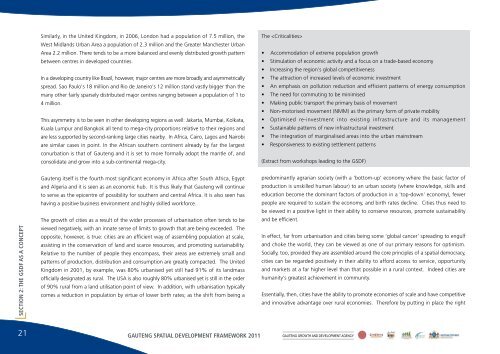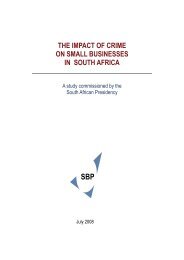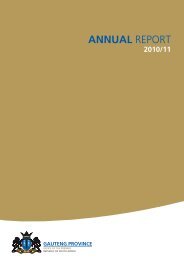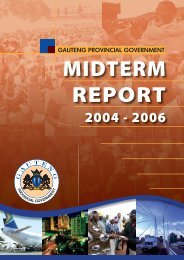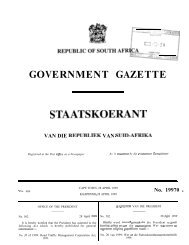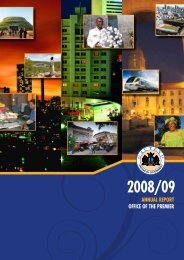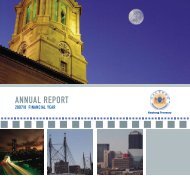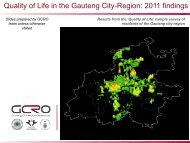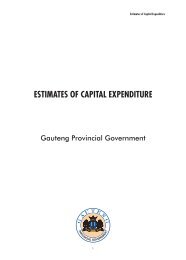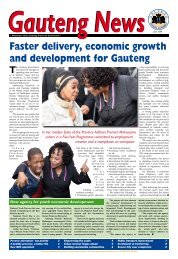the gauteng spatial development framework - Gauteng Online
the gauteng spatial development framework - Gauteng Online
the gauteng spatial development framework - Gauteng Online
Create successful ePaper yourself
Turn your PDF publications into a flip-book with our unique Google optimized e-Paper software.
Similarly, in <strong>the</strong> United Kingdom, in 2006, London had a population of 7.5 million, <strong>the</strong>West Midlands Urban Area a population of 2.3 million and <strong>the</strong> Greater Manchester UrbanArea 2.2 million. There tends to be a more balanced and evenly distributed growth patternbetween centres in developed countries.In a developing country like Brazil, however, major centres are more broadly and asymmetricallyspread. Sao Paulo's 18 million and Rio de Janeiro's 12 million stand vastly bigger than <strong>the</strong>many o<strong>the</strong>r fairly sparsely distributed major centres ranging between a population of 1 to4 million.This asymmetry is to be seen in o<strong>the</strong>r developing regions as well: Jakarta, Mumbai, Kolkata,Kuala Lumpur and Bangkok all tend to mega-city proportions relative to <strong>the</strong>ir regions andare less supported by second-ranking large cities nearby. In Africa, Cairo, Lagos and Nairobiare similar cases in point. In <strong>the</strong> African sou<strong>the</strong>rn continent already by far <strong>the</strong> largestconurbation is that of <strong>Gauteng</strong> and it is set to more formally adopt <strong>the</strong> mantle of, andconsolidate and grow into a sub-continental mega-city.The • Accommodation of extreme population growth• Stimulation of economic activity and a focus on a trade-based economy• Increasing <strong>the</strong> region's global competitiveness• The attraction of increased levels of economic investment• An emphasis on pollution reduction and efficient patterns of energy consumption• The need for commuting to be minimised• Making public transport <strong>the</strong> primary basis of movement• Non-motorised movement (NMM) as <strong>the</strong> primary form of private mobility• Optimised re-investment into existing infrastructure and its management• Sustainable patterns of new infrastructural investment• The integration of marginalised areas into <strong>the</strong> urban mainstream• Responsiveness to existing settlement patterns(Extract from workshops leading to <strong>the</strong> GSDF)SECTION 2: THE GSDF AS A CONCEPT<strong>Gauteng</strong> itself is <strong>the</strong> fourth most significant economy in Africa after South Africa, Egyptand Algeria and it is seen as an economic hub. It is thus likely that <strong>Gauteng</strong> will continueto serve as <strong>the</strong> epicentre of possibility for sou<strong>the</strong>rn and central Africa. It is also seen hashaving a positive business environment and highly skilled workforce.The growth of cities as a result of <strong>the</strong> wider processes of urbanisation often tends to beviewed negatively, with an innate sense of limits to growth that are being exceeded. Theopposite, however, is true: cities are an efficient way of assembling population at scale,assisting in <strong>the</strong> conservation of land and scarce resources, and promoting sustainability.Relative to <strong>the</strong> number of people <strong>the</strong>y encompass, <strong>the</strong>ir areas are extremely small andpatterns of production, distribution and consumption are greatly compacted. The UnitedKingdom in 2001, by example, was 80% urbanised yet still had 91% of its landmassofficially designated as rural. The USA is also roughly 80% urbanised yet is still in <strong>the</strong> orderof 90% rural from a land utilisation point of view. In addition, with urbanisation typicallycomes a reduction in population by virtue of lower birth rates; as <strong>the</strong> shift from being apredominantly agrarian society (with a 'bottom-up' economy where <strong>the</strong> basic factor ofproduction is unskilled human labour) to an urban society (where knowledge, skills andeducation become <strong>the</strong> dominant factors of production in a 'top-down' economy), fewerpeople are required to sustain <strong>the</strong> economy, and birth rates decline. Cities thus need tobe viewed in a positive light in <strong>the</strong>ir ability to conserve resources, promote sustainabilityand be efficient.In effect, far from urbanisation and cities being some 'global cancer' spreading to engulfand choke <strong>the</strong> world, <strong>the</strong>y can be viewed as one of our primary reasons for optimism.Socially, too, provided <strong>the</strong>y are assembled around <strong>the</strong> core principles of a <strong>spatial</strong> democracy,cities can be regarded positively in <strong>the</strong>ir ability to afford access to service, opportunityand markets at a far higher level than that possible in a rural context. Indeed cities arehumanity's greatest achievement in community.Essentially, <strong>the</strong>n, cities have <strong>the</strong> ability to promote economies of scale and have competitiveand innovative advantage over rural economies. Therefore by putting in place <strong>the</strong> right21 GAUTENG SPATIAL DEVELOPMENT FRAMEWORK 2011 GAUTENG GROWTH AND DEVELOPMENT AGENCY


